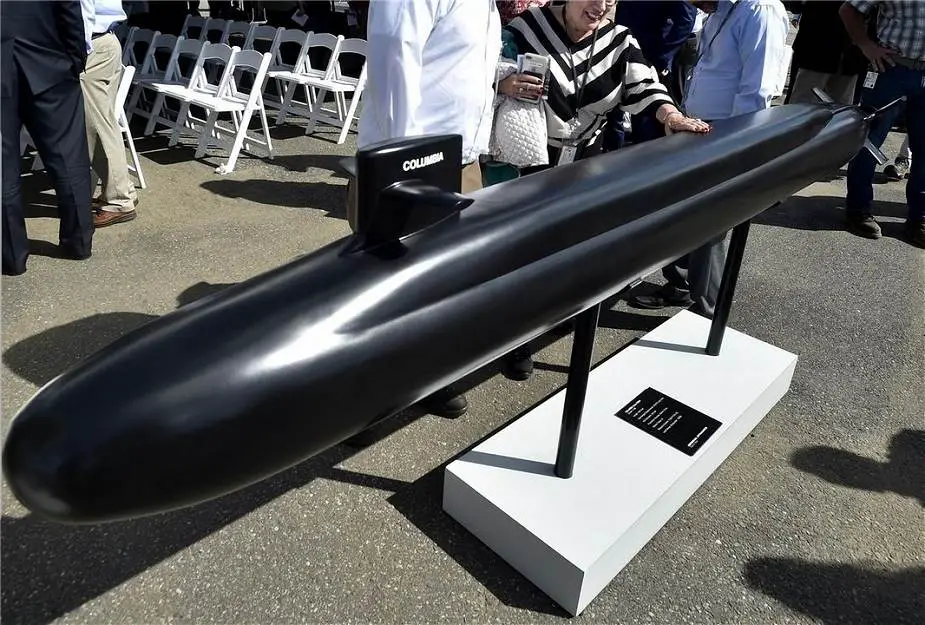Breaking news
New modification contract for General Dynamics for lead yard support of Columbia-class submarines.
According to a contract published by the United States Department of Defense on September 30, 32021, General Dynamics Electric Boat Corp., Groton, Connecticut, is awarded a $475,002,626 cost-plus-fixed-fee and cost-plus-incentive-fee modification to a previously awarded contract for lead yard support efforts serving the entire Columbia-class fleet ballistic missile submarines (SSBNs) through 2028.
Follow Navy Recognition on Google News at this link
 Scale model of Columbia-class submarine. (Picture source Forum Hobby Squawk)
Scale model of Columbia-class submarine. (Picture source Forum Hobby Squawk)
The contract modification also provide continued support for class continuous production of shipyard components, shipyard labor in support of fully outfitted missile tubes, and submarine industrial base development and expansion as part of the integrated enterprise plan (IEP) and multi-program material procurement supporting Columbia SSBNs and the nuclear shipbuilding enterprise (Virginia-class and Ford-class).
Additionally, this modification includes additional IEP investments in production backup units (PBUs) and continuous outfitting of missile tubes. Work will be performed in Groton, Connecticut (97.3%); and Newport News, Virginia (2.7%), and is expected to complete December 2031.
The U.S. Navy’s Columbia (SSBN-826) class ballistic missile submarine (SSBN) is a program to design and build a class of 12 new SSBNs to replace the Navy’s current force of 14 agings Ohio-class SSBNs. Since 2013, the Navy has consistently identified the Columbia-class program as the U.S. Navy’s top priority program. The U.S. Navy procured the first Columbia-class boat in FY2021 and wants to procure the second boat in the class in FY2024.
The U.S. Navy operates three kinds of submarines—nuclear-powered attack submarines (SSNs), nuclear-powered cruise missile submarines (SSGNs), and nuclear-powered ballistic missile submarines (SSBNs). The SSBNs perform a specialized mission of strategic nuclear deterrence. To perform this mission, SSBNs are armed with Submarine-Launched Ballistic Missiles (SLBMs), which are large, long-range missiles armed with multiple nuclear warheads. SSBNs launch their SLBMs from large-diameter vertical launch tubes located in the middle section of the boat. 4 The SSBNs’ basic mission is to remain hidden at sea with their SLBMs, so as to deter a nuclear attack on the United States by another country by demonstrating to other countries that the United States has an assured second-strike capability, meaning a survivable system for carrying out a retaliatory nuclear attack.
The Columbia-class submarine is a nuclear-powered ballistic missile submarine that will have a length of 171 m, a beam of 13 m, and a displacement of 20,810 tons. The nuclear reactor will be used to generate energy, which will be converted into electrical power to fuel the electric propulsion motor. She will be able to reach an unlimited range due to the use of a nuclear reactor and reach a maximum speed of 20 knots (37 km/h) and operate
The Columbia-class design includes 16 SLBM tubes, as opposed to 24 SLBM tubes (of which 20 are now used for SLBMs) on Ohio-class SSBNs. Although the Columbia-class design has fewer SLBM tubes than the Ohio-class design, it is larger than the Ohio-class design in terms of submerged displacement. The Columbia-class design, like the Ohio-class design before it, will be the largest submarine ever built by the United States.




























